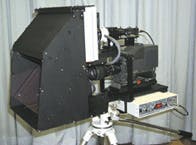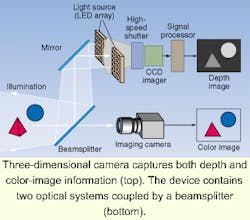Camera records color and depth
Incorporating news from O plus E magazine, Tokyo
TOKYOResearchers at the Japan Broadcasting Company have developed a three-dimensional camera that can simultaneously record depth images along with standard color images (see figure). The camera, which can extract depth information in the direction of the optical axis in real time, contains a beamsplitting mirror that couples the optical system for distance image measurement with the standard color-image-recording system. Possible applications include image manipulation, such as separating objects from a background and placing them in a new background.
For the depth-image measurement, a high-speed infrared two-dimensional (2-D) light-emitting-diode array source is modulated to a triangular waveform at a frequency of 45 MHz. The emitted light is reflected by the mirror and beamsplitter and hits the object. The reflected light goes back through the same optical system and, after passing through a shutter, is recorded by a 2-D charge-coupled-device element. The shutter is synchronized with the light source and remains open for only 1 ns.
Not all the light passing through the shutter at any given instant has been reflected off the objects in the field of view at the same time. The time of flight of a light ray reflecting from an object depends on the distance between the shutter and the object. Therefore, the brightness of the reflected light can show the distance between the object and the camera. By activating the shutter in accordance with the intensity of the incident light, the recorded image can take on a range of intensities corresponding to the distance between the object and the shutter.
One caveat is that the reflectance of the objects depends on the material from which they are made; therefore, one frame alone cannot determine distance. As a remedy, the light source is modulated after every frame, alternating between low and high intensity. The absolute distance of the object can be determined from the ratio of the luminances between the low- and high-intensity frames (distance images can be extracted once every two frames). The calculations are executed within the signal-processing component. The current model can determine depth over a 1.5-3.0-m range. At a distance of 2.5 m, the accuracy of depth information is approximately 1.8 cm.
Further development of the device will lead to higher resolution, resulting in synthetic image formation that will incorporate depth information. The image-synthesis method currently used involves replacing a blue background with another background (the "chromakey" method). Using the new camera, any color background can be used.
Courtesy O plus E magazine


